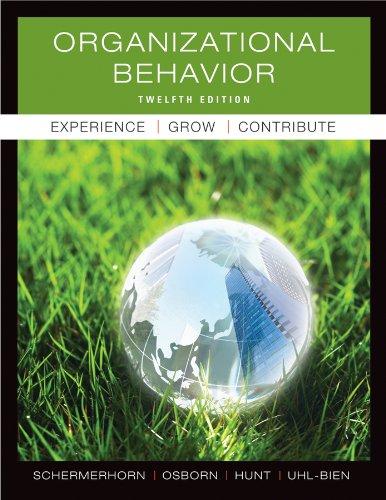Clearly, the workplace of the future will be much more diverse than it is today: more women,
Question:
Clearly, the workplace of the future will be much more diverse than it is today: more women, more people of color, more international representation, more diverse lifestyles and ability profiles, and the like. Managing a diverse workforce and working across a range of differences is quickly becoming a “core competency” for effective managers.
Furthermore, it is also becoming clear that diversity in a work team can significantly enhance the creativity and quality of the team’s output. In today’s turbulent business environment, utilizing employee diversity will give the manager and the organization a competitive edge in tapping all of the available human resources more effectively. This exercise is an initial step in the examination of how we work with people whom we see as different from us. It is fairly simple, straightforward, and safe, but its implications are profound.
Procedure 1. Read the following:
Imagine that you are traveling in a rental car in a city you have never visited before. You have a one-hour drive on an uncrowded highway before you reach your destination. You decide that you would like to spend the time listening to some of your favorite kind of music on the car radio.
The rental car has four selection buttons available, each with a preset station that plays a different type of music. One plays country music, one plays rock, one plays classical, and one plays jazz. Which type of music would you choose to listen to for the next hour as you drive along? (Assume you want to relax and just stick with one station; you don’t want to bother switching around between stations.)
2. Form into groups based on the type of music that you have chosen. All who have chosen country will meet in an area designated by the instructor. Those who chose rock will meet in another area, and so on. In your groups, answer the following question. Appoint one member to be the spokesperson to report your answers back to the total group.
Question For each of the other groups, what words would you use to describe people who like to listen to that type of music?
3. Have each spokesperson report the responses of her or his group to the question in Step 2.
Follow with class discussion of these additional questions:
1. What do you think is the purpose or value of this exercise?
2. What did you notice about the words used to describe the other groups? Were there any surprises in this exercise for you?
3. Upon what sorts of data do you think these images were based?
4. What term do we normally use to describe these generalized perceptions of another group?
5. What could some of the consequences be?
6. How do the perceptual processes here relate to other kinds of intergroup differences, such as race, gender, culture, ability, ethnicity, health, age, nationality, and so on?
7. What does this exercise suggest about the ease with which intergroup stereotypes form?
8. What might be ways an organization might facilitate the valuing and utilizing of differences between people?
Step by Step Answer:

Organizational Behavior
ISBN: 9780470878200
12th Edition
Authors: John R. Schermerhorn, Mary Uhl-Bien, Richard N. Osborn





